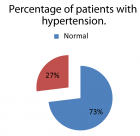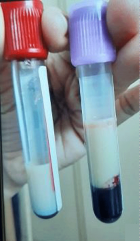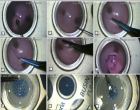Abstract
Case Report
Case reports of observed significant improvement in patients with ARDS due to COVID-19 and maximum ventilatory support after inhalation of sodium bicarbonate
Wardeh A*, Conklin J and Ko M
Published: 19 May, 2020 | Volume 5 - Issue 1 | Pages: 016-019
The emergence of COVID-19 worldwide in an unprecedented pandemic. COVID-19 has a significant mortality, mostly from acute lung injury. We reviewed the available literature from China and Europe in regard to the behavior of SARS-Cov2 and ability to adhere to the cell wall [1,2]. The evidence based literature describes three component for the virus to grant entry to the target cells including Cathepsin B/L (the viral cap protein needed for initial connectivity to the cell wall), the angiotensin converting enzyme 2 and a low PH environment to allow the first connectivity of the virus to the cell wall [3]. The goal of our Case study was to prevent SARS- SARS-Cov2 from entering target cells by raising the airways PH using sodium bicarbonate inhalation. The sodium Bicarbonate inhalation (4.2% concentration) has been used safely in Cystic fibrosis (CF) patients with inspissated mucoid impaction [3,4] and in chloride inhalation toxicity by opposing the effect of the low PH induced by the insulting agent [4,5]. It has not been administered for COVID -19 patients particularly prior to this study.
Read Full Article HTML DOI: 10.29328/journal.jcicm.1001029 Cite this Article Read Full Article PDF
Keywords:
Medical emergency service; Ambulances; Optimization; Simulation; Response time
References
- Chu, V. McElroy, L. Chu, V. Bauman, B. Whittaker, G. The Avian Coronavirus Infectious Bronchitis undergoes direct low PH dependent Fusion activation during entry into the host cells. J Virol. 2006; 80: 3180-3188. PubMed: https://www.ncbi.nlm.nih.gov/pubmed/16537586
- Yong ZY, Huang Y, Ganesh L, Leung K, Kong wp. et al. pH-Dependent Entry of Severe Acute Respiratory Syndrome Coronavirus Is Mediated by the Spike Glycoprotein and Enhanced by Dendritic Cell Transfer through DC-SIGN. J Virol. 2004; 78: 5642-5650. PubMed: https://www.ncbi.nlm.nih.gov/pmc/articles/PMC415834/
- McShane D, Davies JC, Davies MG, Bush A, Geddes DM, et al. Airway surface PH in subjects with cystic fibrosis. Eur Respir J. 2003; 21: 37-42. PubMed: https://www.ncbi.nlm.nih.gov/pubmed/12570106
- Gomez CCS, Parazzi PLF, Clinckspoor KJ, Mauch RM, Pessine FBT, et al, safety, tolerability and effectes of sodium bicarbonate inhalation in cystic fibrosis. Clin Drug Investig. 2019; 40: 105-117. PubMed: https://www.ncbi.nlm.nih.gov/pubmed/31721070
- Aslan S, Kandiş H, Akgun M, Cakir Z, Inandi T, et al. The effect of nebulized sodium bicarbonate treatment on RADS patients due to chlorine gas inhalation. Inhal. Tox. 2006; 18: 895-900. PubMed. https://www.ncbi.nlm.nih.gov/pubmed/16864407
- NIH NHLBI ARDS clinical network, mechanical ventilation protocol summary, 2017.
- Kis A. Toth L, Kunos L, Gyorgy L, Wanner A. The effect of airway alkalinization by nebulized sodium bicarbonate on airway blood flow. European Res. Journal. 2012; 40: P2143.
- Chinese SARS Molecular Consortium. Science 10.1126/science.1092002.
- Bosch BJ, Martina BE, Van Der Zee R, Lepault J, Haijema BJ, et al. Severe ARDS due to SARS CoV infection inhibition using spike protein heptad repeated-derived peptides. Proc Natl Acad Sci USA. 2004; 101: 8455-8460. PubMed: https://www.ncbi.nlm.nih.gov/pubmed/15150417
Figures:

Figure 1

Figure 2

Figure 3

Figure 4
Similar Articles
Recently Viewed
-
A Mini Review of Newly Identified Omicron SublineagesDasaradharami Reddy K*,Anusha S,Palem Chandrakala. A Mini Review of Newly Identified Omicron Sublineages. Arch Case Rep. 2023: doi: 10.29328/journal.acr.1001082; 7: 066-076
-
The Impact of Forensic Science on the Legal System in IndiaSrishti*. The Impact of Forensic Science on the Legal System in India. J Forensic Sci Res. 2025: doi: 10.29328/journal.jfsr.1001072; 9: 001-006
-
Pediatric Dysgerminoma: Unveiling a Rare Ovarian TumorFaten Limaiem*, Khalil Saffar, Ahmed Halouani. Pediatric Dysgerminoma: Unveiling a Rare Ovarian Tumor. Arch Case Rep. 2024: doi: 10.29328/journal.acr.1001087; 8: 010-013
-
Microbiome-Gut-Brain Axis: AI InsightsAmaan Arif, Prekshi Garg, Prachi Srivastava*. Microbiome-Gut-Brain Axis: AI Insights. Insights Biol Med. 2024: doi: 10.29328/journal.ibm.1001027; 8: 001-010
-
Quantification of minor, trace and toxic elements in stems of Santalum album (L.), Mangiferra indica (L.) and Tinospora cordifolia by instrumental neutron activation analysisGarg AN*,Ruchi Singh,Maharia RS,Dutta RK,Arpita Datta. Quantification of minor, trace and toxic elements in stems of Santalum album (L.), Mangiferra indica (L.) and Tinospora cordifolia by instrumental neutron activation analysis. J Plant Sci Phytopathol. 2022: doi: 10.29328/journal.jpsp.1001067; 6: 008-014
Most Viewed
-
Sinonasal Myxoma Extending into the Orbit in a 4-Year Old: A Case PresentationJulian A Purrinos*, Ramzi Younis. Sinonasal Myxoma Extending into the Orbit in a 4-Year Old: A Case Presentation. Arch Case Rep. 2024 doi: 10.29328/journal.acr.1001099; 8: 075-077
-
Evaluation of Biostimulants Based on Recovered Protein Hydrolysates from Animal By-products as Plant Growth EnhancersH Pérez-Aguilar*, M Lacruz-Asaro, F Arán-Ais. Evaluation of Biostimulants Based on Recovered Protein Hydrolysates from Animal By-products as Plant Growth Enhancers. J Plant Sci Phytopathol. 2023 doi: 10.29328/journal.jpsp.1001104; 7: 042-047
-
Feasibility study of magnetic sensing for detecting single-neuron action potentialsDenis Tonini,Kai Wu,Renata Saha,Jian-Ping Wang*. Feasibility study of magnetic sensing for detecting single-neuron action potentials. Ann Biomed Sci Eng. 2022 doi: 10.29328/journal.abse.1001018; 6: 019-029
-
Physical activity can change the physiological and psychological circumstances during COVID-19 pandemic: A narrative reviewKhashayar Maroufi*. Physical activity can change the physiological and psychological circumstances during COVID-19 pandemic: A narrative review. J Sports Med Ther. 2021 doi: 10.29328/journal.jsmt.1001051; 6: 001-007
-
Pediatric Dysgerminoma: Unveiling a Rare Ovarian TumorFaten Limaiem*, Khalil Saffar, Ahmed Halouani. Pediatric Dysgerminoma: Unveiling a Rare Ovarian Tumor. Arch Case Rep. 2024 doi: 10.29328/journal.acr.1001087; 8: 010-013

HSPI: We're glad you're here. Please click "create a new Query" if you are a new visitor to our website and need further information from us.
If you are already a member of our network and need to keep track of any developments regarding a question you have already submitted, click "take me to my Query."


















































































































































